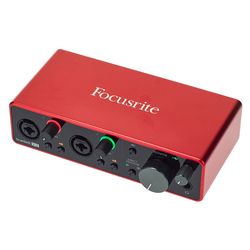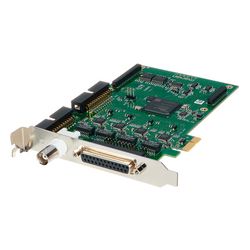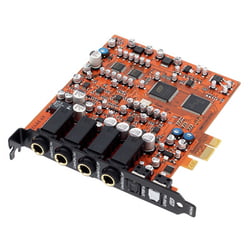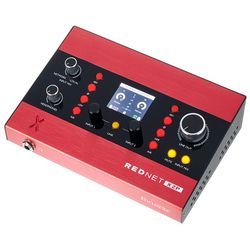What number and type of inputs and outputs does an audio interface need to have?
Audio interfaces are available with a single input (also known as a "channel" or "input channel") and a single stereo output, but models with eight or 16 input and output channels are also available. Microphones are one of the most frequently connected sources, so many interfaces accordingly have onboard mic preamps; synthesizers, drum machines, electric guitars and basses, and even effects units and mixing desks/DJ mixers can be connected to an audio interface and recorded to a computer.
The audio interface's outputs are normally used to connect monitor speakers and headphones, in addition to which many interfaces also feature digital and MIDI connections, allowing keyboards, sound generators, effects units, mixing desks, and controllers to communicate with the computer.
Audio interface inputs can be used to record and stream with:
-
Microphones
-
Line-level signals (effects units, keyboards/synths/etc. and mixing desks/DJ mixers)
-
Instrument signals (electric guitars, electric basses)
-
Digital audio signals (low-loss signals from other digital devices)
-
MIDI (control signals, non-audio signals)
Audio interface outputs can be used to play back:
-
Line-level signals (for playback via speakers during signal editing)
-
Headphone signals
-
Digital audio signals
-
MIDI
Does an audio interface need to have an onboard monitoring controller?
It is not always necessary to have a separate monitoring controller to adjust the volume of the headphone or speaker output. However, a direct monitoring option is important when recording to a playback track from a computer, as this ensures that the line/microphone signal can be blended with the playback track with no time lag (know as "latency").
Which brand makes the best audio interface?
There is no single "best" audio interface, but everyone can certainly find the right one for their needs. For example, high-end interfaces are available from manufacturers like Apogee, Prism Sound, Metric Halo, and RME. More budget-friendly models are in turn available from the t. bone, IK Multimedia, Behringer, and many others, while brands like Focusrite and Universal Audio offer audio interfaces at multiple different price points. Popular manufacturers additionally include MotU, SSL, and Audient, to name just a few examples.
Where can I find the right audio interface at Thomann?
-
USB interfaces | USB audio interfaces represent the category with the broadest available selection, which encompasses everything from the compact MicPlug USB microphone preamp with integrated AD/DA converter from the t.bone through to large high-end interfaces. A wide range of more specialised audio interfaces are also available that are tailored to the needs of guitarists, podcasters, and others.
-
Thunderbolt interfaces | High-performance audio interfaces and those with a large number of inputs and outputs are frequently connected via Thunderbolt.
-
Ethernet interfaces | Ethernet interfaces can be used to create large and expansive setups in recording and broadcast studios, but are better left to professional users due to their high level of complexity.
-
PCI and PCIe interfaces | Soundcards were previously the standard, but are now no longer commonly used.
-
Firewire interfaces | The Firewire interface standard is approaching obsolescence, and is thus seldom found on audio interfaces today. | Note: Many interfaces feature a range of different connection options!
-
DSP audio systems | The term "DSP" does not refer to the connection standard in this case, rather it denotes audio interfaces that are equipped with their own processors for computing specific effect plugins. Many of these interfaces do not feature any kind of audio connections and are equipped only with DSPs.











)
)